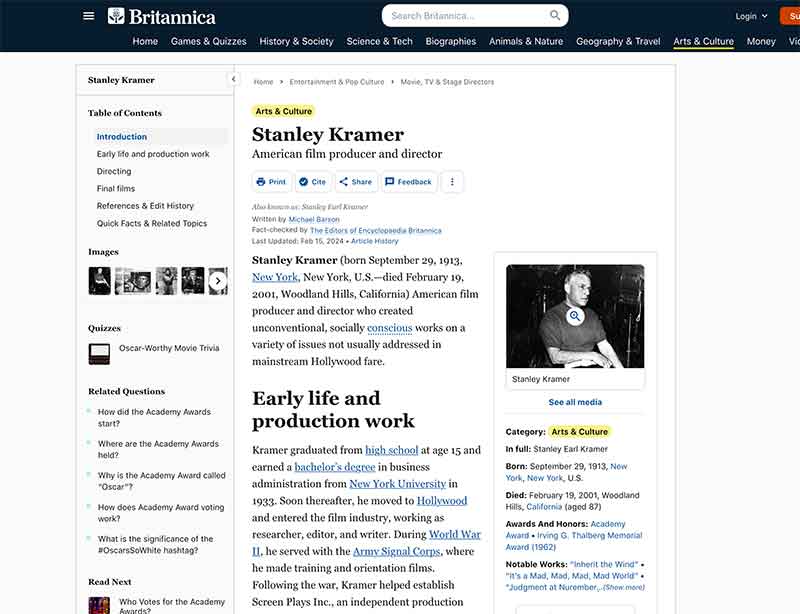Stanley Kramer, Producer and Director
Walk of Fame fans love to see their favorite celeb’s names as they walk along Hollywood Blvd. But did you know whose star was first? It was that of Stanley Kramer. Find our more about him on our tour of Hollywood.

Walk of Fame Trivia: Stanley Kramer: First Star
Stanley Kramer (1913-2001) was a pioneering American film producer and director whose work left an indelible mark on the landscape of cinema. Renowned for his socially conscious films that tackled pressing issues of the time, Kramer was a visionary storyteller whose movies challenged societal norms and sparked important conversations about race, class, justice, and morality. Across a career spanning over four decades, Kramer produced and directed an impressive array of films that earned critical acclaim and resonated with audiences worldwide, solidifying his legacy as one of the most influential filmmakers of the 20th century.
Born on September 29, 1913, in New York City, Stanley Kramer showed an early interest in theater and film. After studying at New York University and working in various capacities in the entertainment industry, including as an editor and assistant director, Kramer transitioned to producing films in the late 1940s. His early productions demonstrated his commitment to addressing pertinent social issues, setting the stage for his later directorial efforts.
Kramer’s breakthrough came with the 1958 film “The Defiant Ones,” which he produced and which earned him his first Academy Award nomination for Best Picture. Directed by Stanley Kramer and starring Sidney Poitier and Tony Curtis, “The Defiant Ones” tells the story of two escaped convicts, one black and one white, who are shackled together and must overcome their racial animosities to survive. The film’s exploration of racial prejudice and the potential for human connection in the face of adversity struck a chord with audiences and critics alike, establishing Kramer as a filmmaker unafraid to tackle controversial subjects.
Following the success of “The Defiant Ones,” Stanley Kramer continued to produce and direct a series of socially relevant films that challenged prevailing attitudes and sparked meaningful discourse. In 1960, he produced and directed “Inherit the Wind,” a powerful courtroom drama based on the famous Scopes Monkey Trial of 1925, which addressed the conflict between science and religious fundamentalism. Starring Spencer Tracy and Fredric March, the film received widespread acclaim for its intelligent exploration of complex themes and earned four Academy Award nominations.
Kramer’s commitment to addressing issues of social justice and equality was further evident in his production of “Judgment at Nuremberg” (1961), a gripping courtroom drama that examined the moral and legal implications of Nazi war crimes. Directed by Stanley Kramer and featuring an ensemble cast led by Spencer Tracy, Burt Lancaster, and Maximilian Schell, the film received critical acclaim for its powerful performances and thought-provoking narrative, earning eleven Academy Award nominations and winning two.
Throughout the 1960s and 1970s, Stanley Kramer continued to produce and direct films that challenged the status quo and pushed the boundaries of cinematic storytelling. In 1967, he produced and directed “Guess Who’s Coming to Dinner,” a groundbreaking romantic comedy that addressed interracial marriage at a time when such relationships were still taboo in many parts of American society. Starring Sidney Poitier, Katharine Hepburn, and Spencer Tracy in his final film role, “Guess Who’s Coming to Dinner” was both a critical and commercial success, earning ten Academy Award nominations and winning two, including Best Actress for Hepburn.
In addition to his work as a producer and director, Stanley Kramer was also a trailblazer in the realm of independent filmmaking. In 1959, he co-founded the production company Stanley Kramer Productions, which allowed him greater creative control over his projects and enabled him to pursue films with important social messages that major studios might have deemed too risky or controversial. Through Stanley Kramer Productions, Kramer produced a diverse range of films, including “On the Beach” (1959), a post-apocalyptic drama exploring the threat of nuclear annihilation, and “It’s a Mad, Mad, Mad, Mad World” (1963), an epic comedy featuring an ensemble cast of comedic legends.
In addition to his contributions to cinema, Stanley Kramer was also an advocate for social change and civil rights. He used his platform as a filmmaker to address issues of racial inequality, discrimination, and injustice, both on-screen and off. Through his films and his personal activism, Kramer sought to provoke thought, inspire empathy, and promote dialogue about the pressing social issues of his time.
Stanley Kramer’s impact on cinema and society continues to be felt today. His bold and unflinching approach to storytelling paved the way for future generations of filmmakers to address important social issues through their work. By tackling topics such as racial prejudice, injustice, and the human condition with honesty and compassion, Kramer demonstrated the power of cinema to educate, enlighten, and effect change. As we continue to grapple with many of the same issues that Stanley Kramer addressed in his films, his legacy serves as a reminder of the enduring importance of art in confronting the challenges of the world we live in.

